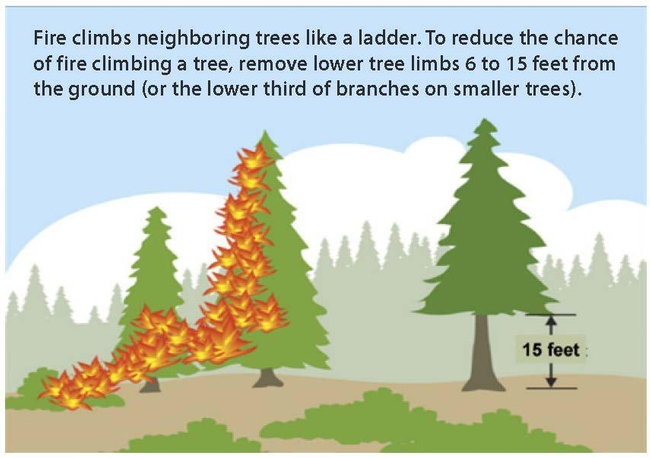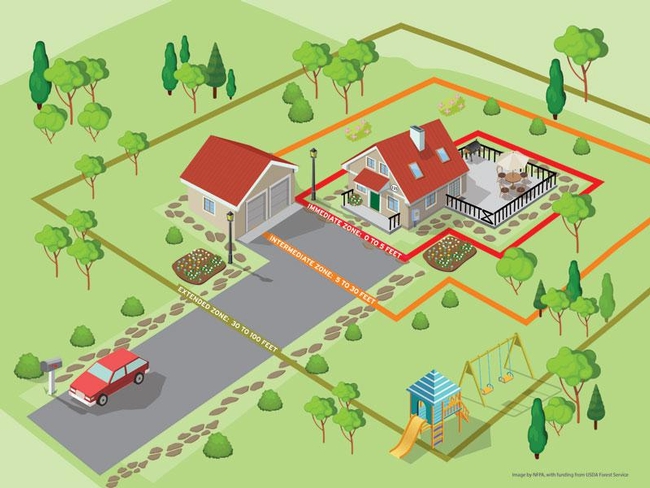As our cities and towns continue to sprawl, an increasing number of Californians live in the urban-wildland interface where the threat of fires is particularly significant. The urban-wildland interface is the area where urban and suburban development meets underdeveloped areas containing natural vegetation. These areas can be a beautiful place to live, but they are not without the risk of wildfires. When conditions are windy and dry, the grasses, brush, trees, or other vegetation surrounding a home becomes a dangerous fuel source which can be quite flammable during the hot summer and early fall months. California's native vegetation has evolved in response to wildfire, and many species depend upon periodic burns for rejuvenation or reproduction. Because of this, many structures are destroyed by wildfire every year within the jurisdiction of CAL FIRE.
However, homes are being saved because of homeowners' careful implementation of techniques that increase the fire safety of their landscape which minimizes the ignition of vegetation. As a result, the fire resistant landscape has become a hot topic for homeowners who live in Northern and Southern California where danger is especially prevalent in hills and wooded areas.
A prudent homeowner will want to follow safety precaution practices concerning the location of plants and building material that can compromise the home in the event of a wildfire. As a rule of thumb, homeowners need to make sure that fire moving toward their property cannot follow a continuous path through vegetation. With this in mind, the "fire ladder" concept is essential, especially near structures where the fire reaches shrubs or limbs below the canopy and can 'climb the ladder' and expand from ground level to tree canopy. These vertical columns of vegetation provide a continuous fuel supply that enables fires to spread rapidly throughout the landscape.
Thus, it is recommended that trees with significant canopy be planted at far enough distances from a house so horizontal branches do not carry their foliage within ten feet of the structure. Lower branches of trees should be pruned regularly, and nothing should be growing below the canopy of trees. Deciduous trees are generally more fire-resistant than evergreen because they have higher moisture content in their leaves. Further, arrange landscape features in horizontal and vertical spaces to disrupt the fire. Periodically reduce fuel loads by thinning trees and shrubs or heavily pruning species that can re-sprout from basal burls.
Experts do agree that beneficial practices implemented in a high-fire area such as: removing dead vegetation branches; selectively thinning woody plants and keeping vegetation away from the roofs and eaves of any buildings; and replacing building materials that are an invitation to disaster, such as wooden shingles, siding, and decks, are vital to safeguard a property.

Only vegetation that does not ignite easily should be planted in this area. Only fire-retardant plants should be planted with 50 to 75 feet of a home or structure. Also, this provides not only an essential aesthetic element in the garden, but also delivers small buffer zones making it more difficult for a fire to travel horizontally, leaping from plant to plant.
When appropriate, maintain a greenbelt of moisture-retentive, low-growing vegetation in a 30-foot wide strip surrounding the home. For example, healthy lawns, ground covers, and perennials form a greenbelt in the home defense zone. So, a defensible space is only part of a broader landscape management strategy designed to protect and defend a property from wildfires. Similarly, a fire zone can be created by using stone walls, patios, gravel, and roadways.
To design a fire-resistant landscape, choose features like mulch, pavement, planters, and plants. In fact, there are conflicting opinions regarding which plants are fire-safe versus which are highly flammable. Some plants are described and marketed as fire-resistant; yet it is essential to remember that, in view of certain conditions, all plants can burn regardless of how they are classified. When choosing plants for a fire-safe landscape, select plants with high moisture content in leaves, as they ignite and burn more slowly. Make sure that plants are small and broken in clusters in a mosaic pattern. Some native plants, such as chamise and exotic eucalyptus, have been identified as poor choices for home landscapes at the wildland's edge.
However, how plants are maintained and where they are placed is as important as the species chosen. Cultural practices and landscape management have a greater impact on whether a plant ignites than does the species.
Carefully choose where to place plants or garden beds that will need mulch. Mulches are beneficial because they retain moisture, reduce weed growth, and cover up weed cloth. However, be mindful not to use too much bark mulch in garden beds near the home or outbuilding. In general, particles or stringy mulches smaller than a ¼ inch ignite and burn more rapidly that large chunks. Limit leaf litter and mulch layers to four inches in depth.
Additionally, when exposed to fire, thick mulches greater than 2 inches deep tend to smoke and are hard to put out. Do not place wood or use bark mulches within 3 to 5 feet of the house. Instead, consider colored rocks or other less-flammable materials.
Cut back grasses and wildflowers as they brown, although the homeowner may want to leave some patches for seed harvesting, reseeding, or wildlife. Maintain landscape features by keeping plants alive, healthy, and well pruned. Concentrate on removing dead and diseased wood as needed, at least annually. Do not allow debris to accumulate near the home and avoid invasive weedy plants that may take over an area near the house.
Furthermore, drip irrigation systems are effective and conserve water because they target where the water goes and control the quantity. Use sprinklers for lawns and ensure that the grass is getting enough water to keep it green, healthy, and thereby fire resistant. Also, it would be useful (cost permitting) to install an independent irrigation valve with sprayers that can water the area around a home in the event of a fire. Realize however that in a firestorm, everything will burn.
Consequently, proper and careful planning of a home landscape can yield a beautiful garden and a fire-safe home by the implementation of techniques such as a green belt around the property. Removing dead vegetation and branches, selectively thinning woody plants, keeping vegetation away from roofs and eaves, replacing flammable building materials, and using landscape features that increase the fire-safety of property are all practices that enable the fire department to access and defend your home in the event of a wildfire (Cal Fire).
For more information about this topic please visit the links below.
